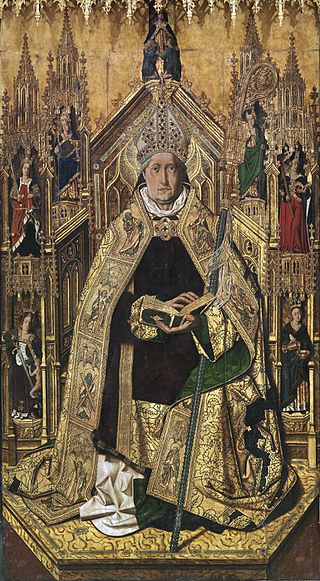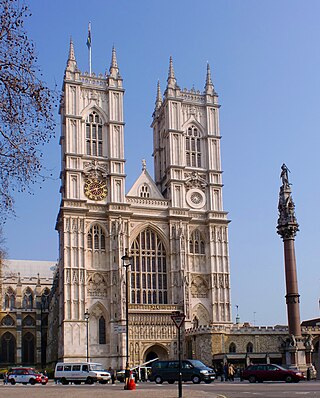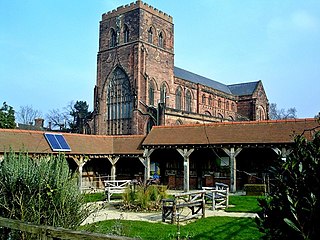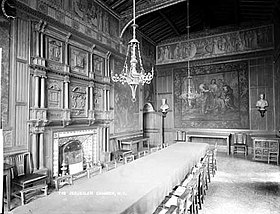
Abbot is an ecclesiastical title given to the head of an independent monastery for men in various Western Christian traditions. The name is derived from abba, the Syriac form of the Hebrew ab, and means "father". The female equivalent is abbess.

An abbey is a type of monastery used by members of a religious order under the governance of an abbot or abbess. Abbeys provide a complex of buildings and land for religious activities, work, and housing of Christian monks and nuns.

Westminster Abbey, formally titled the Collegiate Church of Saint Peter at Westminster, is an Anglican church in the City of Westminster, London, England. Since 1066, it has been the location of the coronations of 40 English and British monarchs and a burial site for 18 English, Scottish, and British monarchs. At least 16 royal weddings have taken place at the abbey since 1100.

Henry IV, also known as Henry Bolingbroke, was King of England from 1399 to 1413. Henry was the son of John of Gaunt, Duke of Lancaster, and Blanche of Lancaster.

Holyrood Abbey is a ruined abbey of the Canons Regular in Edinburgh, Scotland. The abbey was founded in 1128 by David I of Scotland. During the 15th century, the abbey guesthouse was developed into a royal residence, and after the Scottish Reformation the Palace of Holyroodhouse was expanded further. The abbey church was used as a parish church until the 17th century, and has been ruined since the 18th century. The remaining walls of the abbey lie adjacent to the palace, at the eastern end of Edinburgh's Royal Mile. The site of the abbey is protected as a scheduled monument.

Basingwerk Abbey is a Grade I listed ruined abbey near Holywell, Flintshire, Wales. The abbey, which was founded in the 12th century, belonged to the Order of Cistercians. It maintained significant lands in the English county of Derbyshire. The abbey was abandoned and its assets sold following the Dissolution of the Monasteries in 1536.

St Benet's Hall was a permanent private hall (PPH) of the University of Oxford, originally a Roman Catholic religious house of studies. It closed in 2022. The principal building was located at the northern end of St Giles' on its western side, close to the junction with Woodstock Road, Oxford.
Thomas Walsingham was an English chronicler, and is the source of much of the knowledge of the reigns of Richard II, Henry IV, Henry V and the latter reign of Edward III depicting the decline of the state of affairs of the English. He also documented the careers of John Wycliff and Wat Tyler.
'I was glad' is an English text drawn from selected verses of Psalm 122. It has been used at Westminster Abbey in the coronation ceremonies of British monarchs since those of King Charles I in 1626.

A chapter house or chapterhouse is a building or room that is part of a cathedral, monastery or collegiate church in which meetings are held. When attached to a cathedral, the cathedral chapter meets there. In monasteries, the whole community often met there daily for readings and to hear the abbot or senior monks talk. When attached to a collegiate church, the dean, prebendaries and canons of the college meet there. The rooms may also be used for other meetings of various sorts; in medieval times monarchs on tour in their territory would often take them over for their meetings and audiences. Synods, ecclesiastical courts and similar meetings often took place in chapter houses.

Bruern or Bruern Abbey is a hamlet and civil parish on the River Evenlode about 6 miles (10 km) north of Burford in West Oxfordshire. The 2001 Census recorded the parish population as 62.
The Henry Bradshaw Society is a British-based text publication society founded in 1890 for the scholarly editing and publication of rare liturgical texts.
Anthony Kitchin, also known earlier as Dunstan Kitchin, was a mid-16th-century Abbot of Eynsham Abbey and then, Bishop of Llandaff in the Catholic Church under Henry VIII and eventually under Mary. He Seems to have had no qualms about the breach with Rome under Henry VIII, the Protestant Reformation under Edward VI and though reconciled as a Catholic under Mary I, accepted to serve when Protestantism returned under Elizabeth I.

The Painted Chamber was part of the medieval Palace of Westminster. It was gutted by fire in 1834, and has been described as "perhaps the greatest artistic treasure lost in the fire". The room was re-roofed and re-furnished to be used temporarily by the House of Lords until 1847, and it was demolished in 1851.
Thomas Mylling was a medieval Bishop of Hereford. He was Abbot of Westminster from 1469 to 1474. He was nominated as bishop on 22 June 1474 and consecrated on 21 August 1474. He died on about 12 January 1492.
Events from the 1410s in England.
The State Opening of Parliament includes a State Procession, a formal display of the Sovereign, dignified by a sizeable entourage made up of Great Officers of State and members of the Royal Household. The State Procession is now confined to the interior of the Palace of Westminster, but in earlier centuries it followed an outdoor route to and from Westminster Abbey.

Thomas Prestbury was an English medieval Benedictine abbot and university Chancellor.
The history of the Palace of Westminster began in the Middle Ages – in the early eighth century – when there was an Anglo-Saxon church dedicated to St. Peter the Apostle which became known as the West Minster. In the tenth century the church became a Benedictine abbey and was adopted as a royal church, which subsequently became a royal palace in the 11th century.












